Increased Data Usage is Taking Swimming Into the Future
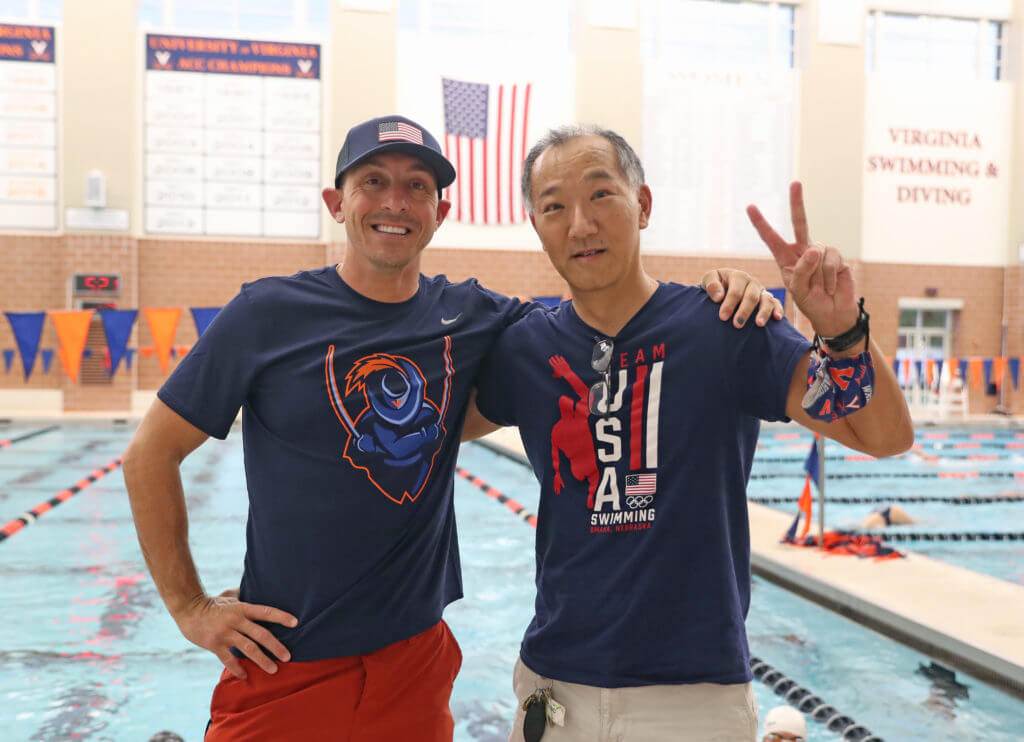
Once Largely Dismissed, Data Usage is Taking Swimming Into the Future
Russell Mark knew the look before coaches even had to open their mouths.
It was the early 2000s, and Mark had worked his way from a research assistant to a biomechanics analyst with USA Swimming. Using video technology, he prepared detailed reports on swimmers’ race performance, on stroke rate, tempo, splits atomized into minute detail, comparisons of racers against their competition and against past races.
As often as not, that information fell on ears less deaf than intentionally unwilling to hear.
“We would print out reports of the race data and I would walk around as an intern and hand them to coaches, and half the coaches would look at it like, what are you handing me?,” Mark said.
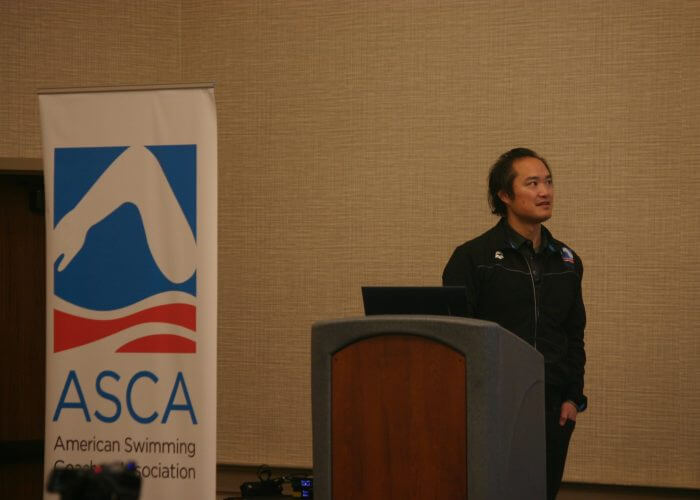
Russell Mark at the 2025 ASCA Pacific Coaches Clinic
That has changed in the more than two decades that Mark has been working on pool decks and in the metaphorical laboratory – in part thanks to refinements in his methods, in part because of his and others’ success stories, and in part through the simple passage of time. Now a performance and education advisor with the American Swimming Coaches Association, Mark has lived through the changes. Work that once was at best benignly tolerated by many coaches is now sought out. The swimmer’s urge to ask, “what was my split?” after a race has morphed into many more granular questions, ones that Mark and analysts like him can measure in greater detail and disseminate more quickly. The hunger for data permeates many of the country’s top programs, at the club and collegiate level, as well as the long push Mark led within USA Swimming before his departure from the organization in 2021.
Like many sports, swimming has undergone an analytics revolution, albeit one behind the scenes. It is an inherently quantifiable sport. But where other sports have introduced quantitative measures into qualitative endeavors, swimming has sought to add dimensions to the singular measure of success that is a watch time. Work in and out of the pool can decipher areas of strength and weakness, evaluate progress and illuminate the sometimes vague question of what is working and why. It has happened in an environment of curiosity, where progress in one part of the realm can quickly filter to others. All the high-tech analysis relies on the very low-tech relationship between coach and athlete.
“It’s way more part of the process,” Mark said. “Coaches have way more of an appetite for it, and all this stuff is more integrated than it was 20 years ago. It’s awesome, and I appreciate how much I’ve been able to see that evolution and live it.”
The Mathematician Behind the Medals
Swimming at the University of Virginia has become an immersive laboratory, with results that speak for themselves.
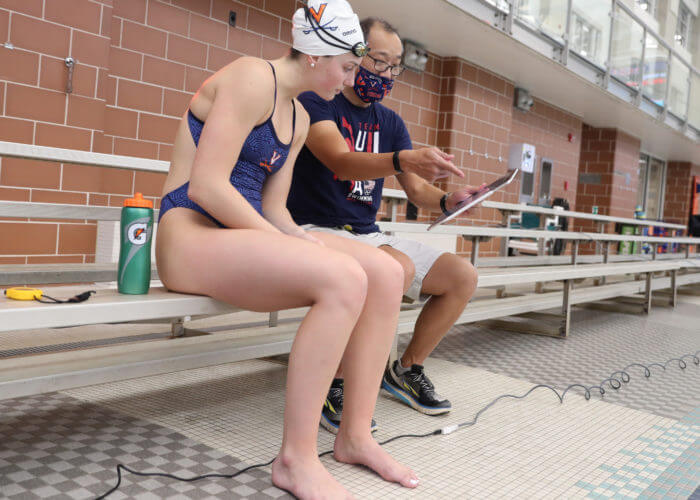
Dr. Ken Ono, right, with Alex Walsh; Photo Courtesy: Matthew Kent Riley/University of Virginia
The hands-on practicality of swimming long held an appeal to Dr. Ken Ono. A professor of mathematics, he delved deep into swimming when his son, Sage, embarked on a successful career at Division III powerhouse Emory University. One of Sage’s teammates was a physics and applied mathematics major named Andrew Wilson who wondered how his course of study might help his breaststroke.
Wilson grew into a national champion and the first D-III swimmer to make the U.S. Olympic Team, earning a gold medal in the men’s medley relay in Tokyo.
Ono would find other intellectually kindred spirits when he moved to Virginia in 2019, among them research assistant and “technical performance consultant” Jerry Lu, a club swimmer who prioritized Virginia’s academics over his collegiate swimming prospects. They bonded over a distinct dearth of “how” in swimming instruction – how exactly does one get faster; how even does one quantify what it means to be fast beyond the watch time – and sought to explore it.
Lu and Ono developed a testing protocol to evaluate swimmers. Outfitted with cameras and wearable accelerometers, using force pads and high-speed motion tracking, they can break a swim down into hundreds of discreet variables, from power generated by each side of the body to each kick’s efficiency in translating effort into propulsion to the effect of streamline technique on drag. Armed with detailed knowledge, swimmers are better equipped to head back to the practice pool with specific areas to polish.
Ono’s work has yielded massive improvements, making Virginia a five-time national champion on the women’s side. He’s worked with Olympic medalists like Gretchen Walsh, Alex Walsh, Kate Douglass and Paige Madden, plus dozens of swimmers levels down from the elite who used data-driven insights to become the best versions of themselves. He and coach Todd DeSorbo are exporting the idea into Velocity Swim Labs, an immersive camp that allows visiting swimmers to undergo their battery of testing.
Data in the Desert
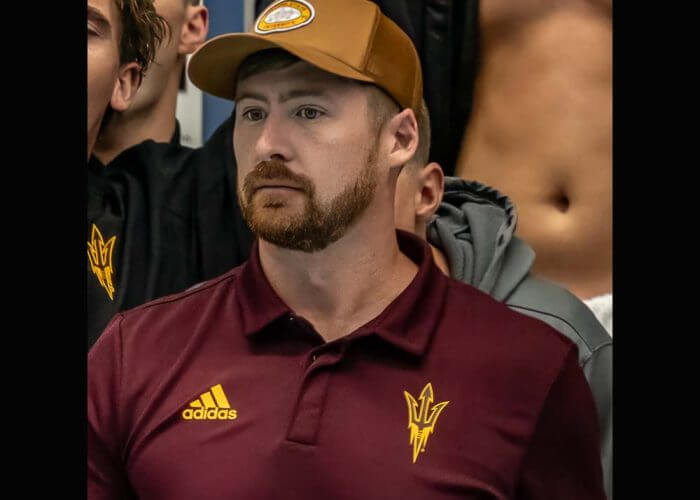
Photo Courtesy: Peter H. Bick
Both national champions in 2024 were driven by a data-centric approach to training. Much as the Arizona State men’s team was the product of rapid improvement under legendary coach Bob Bowman, it also owed to a nuanced view of improvement fueled by Herbie Behm, the associate head coach who would take over the head job upon Bowman’s departure for the University of Texas.
Behm has become renowned for his work with sprinters in particular. He turned 200 butterflier Ilya Kharun into a 100 fly Olympic medalist. His presence in Tempe has attracted sprinters like Michael Andrew, Marie Wattel and Taylor Ruck long after Bowman’s departure.
Behm uses data to keep the training load he writes into sets ahead of what his swimmers are capable of. It adheres to the law of accommodation, the notion that a training challenge will become less effective the more it’s repeated, eventually dulling progress as the body adapts to the load. Injecting novelty isn’t just important psychologically but physiologically, to keep muscles challenged. This relies on progressive overload, designing training regimens that are constantly increasing in difficulty, filtering out repetition for repetition’s sake and eliminating biologically monotonous challenges.
“Everyone has different capacities,” Behm said recently. “The point is to improve those capacities constantly throughout a season/career. Once you find that capacity, training must constantly stimulate the athlete in a way to stimulate constant adaptation.”
Among Behm’s early hires upon taking over for Bowman were the revered Dave Salo, an old-school coach who nonetheless has long espoused new-school methods about sprint training, and data scientist Corey Manley, “a brilliant human being” in Behm’s words who spent a year as USA Swimming’s data scientist. The effort requires both qualitative changes, like using different drills and motions to prevent swimmers’ bodies from betting comfortable in too much of a routine, to the need to measure progress in minute sections.
Putting the Data to Work
Mark’s work straddles two important axes prevalent in all the data-driven work.
Where Ono and others use wearable sensors to measure force and acceleration, Mark’s data is all about video. His deployment of underwater camera arrays has come miles, from his first experience shoving a security camera into a PVC pipe at the 2002 National Championships in Fort Lauderdale to waterproof it. Now something as simple as a GoPro can capture video at high resolution and nearly instant feedback to inform workouts, something coaches can show on a screen poolside between reps.
“I love showing good examples,” Mark said. “There’s nothing more valuable than having a visualization of good technique.”
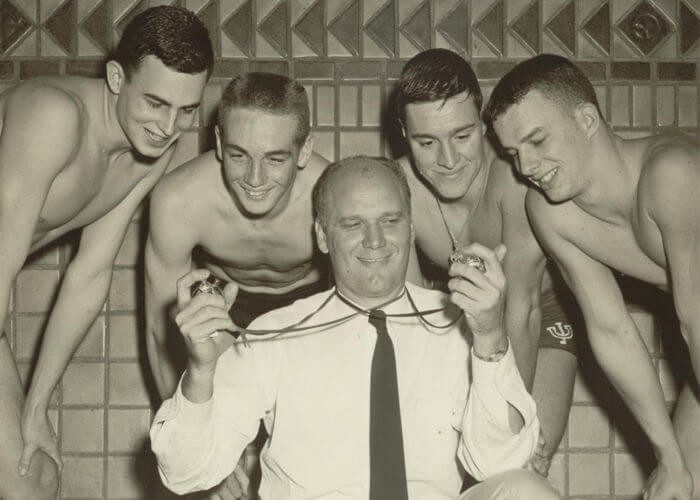 In that way, Mark is an heir to the lineage that includes Doc Counsilman’s groundbreaking underwater photographs of swimmers in action. That work, done in the 1960s, was a technological leap, the Hall of Fame Indiana University coach overcoming technical challenges to get undistorted, measurable and repeatable photos of swimmers at full speed.
In that way, Mark is an heir to the lineage that includes Doc Counsilman’s groundbreaking underwater photographs of swimmers in action. That work, done in the 1960s, was a technological leap, the Hall of Fame Indiana University coach overcoming technical challenges to get undistorted, measurable and repeatable photos of swimmers at full speed.
But much of the data is qualitative – move your arm a little this way; change your body rotation a few degrees – rather than quantitative. Better technology translates those observations into numbers, and the numbers give a way to verify and test what used to be more gauzy notions of coaching wisdom.
“So much of swim coaching is qualitative, and I think there has to be an appreciation for that,” Mark said. “U.S. coaches and the community in the U.S. has a lot of the best coaches at doing the qualitative stuff, and that’s a huge part of great coaching. There’s always a challenge to turn it into quantitative data.”
Mark, like Ono and Behm, faces the same challenge of communication. You can tell a swimmer that their arm is pronated 15 degrees in the wrong direction or that increasing kick amplitude 10 percent will help, but that’s not always actionable in a workout or a race. Coaches – or in Ono’s case, swimmers turned research assistants – are often the conduit of information from the spreadsheet to the pool deck. It’s part of the reason why Ono has deputized swimmers as research assistants, to tap into a common language in disseminating information in a digestible way.
“This is a constant conversation between athlete and coach that I believe must happen daily,” Behm said. “At meets we discuss the data points done in practice, and at practice we discuss what we learned at the meet. It’s more of a feedback loop rather than a one-sided discussion.”
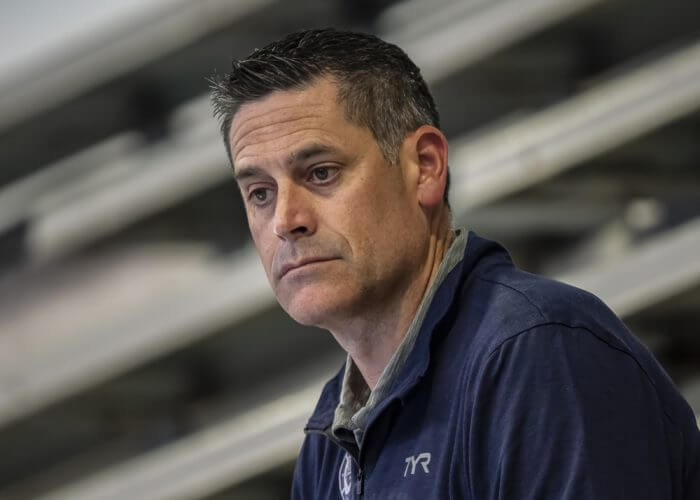
greg-meehan-
Mark has seen that relationship with coaches change. He worked last NCAA season with Stanford University, finding in coach Greg Meehan one of the more receptive ears to the implementation of data. (It’s probably not a coincidence the last two Olympic women’s head coaches, Meehan and DeSorbo, are heavily influenced by the use of data, and it speaks well for Meehan’s approach in his new role as the Managing Director of the National Team.)
Coaches must have a foot in both worlds, able to speak the language of data and of swimmers to relate it into practice.
“The coaches are the one that are the filter for it,” Mark said. “I’m giving them some thoughts, and the coaches are speaking the athlete’s language.”
Equally important is scalability. Mark knows there’s no purpose in showing video of Michael Phelps and saying, swim like that. Ono’s research focuses on longitudinal assessments of individuals, how each swimmer improves from past versions of themselves.
Mark isn’t looking for a template or a default mode of swimming, since bodies are infinitely variable and there’s no one right way to move fast in the water. It’s not about using data to conform everyone into a robotic blueprint – a downfall of data in some sports like baseball – but to bring out the best in each individual.
“It’s about understanding and respecting each swimmer’s individual and unique strengths and what those opportunities are,” he said. “It’s not a cut-and-paste equation that makes someone the best.”



